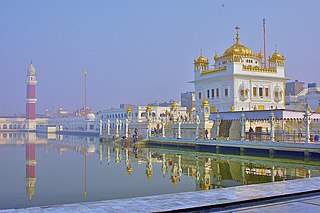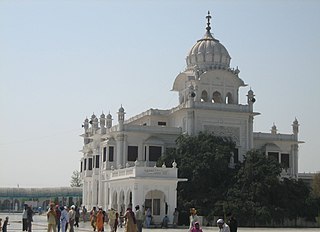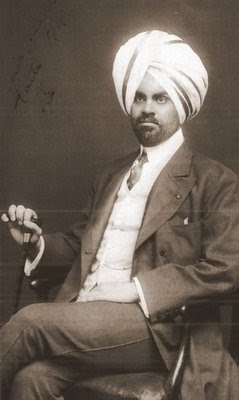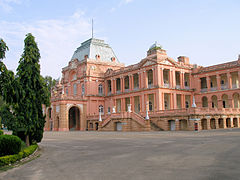
Nankana Sahib is a city and capital of Nankana Sahib District in the Punjab province of Pakistan. It is named after the first Guru of the Sikhs, Guru Nanak, who was born in the city and first began preaching here. Nankana Sahib is among the most important religious sites for the Sikh religion. It is located about 91 km (57 mi) west of Lahore and about 75 km (47 mi) east of Faisalabad. According to the census of 2017 the city has a population of 110,135 inhabitants. Until 2005, it was a part of the Sheikhupura District.

A gurdwara or gurudwara is a place of assembly and worship for Sikhs but its normal meaning is place of guru or "Home of guru". Sikhs also refer to gurdwaras as Gurdwara Sahib. People from all faiths and religions are welcomed in gurdwaras. Each gurdwara has a Darbar Sahib where the Guru Granth Sahib is placed on a takht in a prominent central position. Any congregant may recite, sing, and explain the verses from the Guru Granth Sahib, in the presence of the rest of the congregation.

Tarn Taran Sahib is a city in the Majha region of the state of Punjab, in northern India. It is the district headquarters and hosts the municipal council of Tarn Taran district. Gurdwara Sri Tarn Taran Sahib, a prominent Sikh shrine, is located in the central part of the city.

Batala is the eighth largest city in the state of Punjab, India in terms of population after Ludhiana, Amritsar, Jalandhar, Patiala, Bathinda, Mohali and Hoshiarpur. Batala ranks as the second-oldest city after Bathinda. It is a municipal corporation in Gurdaspur district in the Majha region of the state of Punjab. It is located about 32 km from Gurdaspur, the headquarters of the district. It is also a Police district. Batala holds the status of the most populated town of the district with 31% of the district's total population. It is the biggest industrial town in the district.

Shaheed Bhagat Singh Nagar district is one of twenty-three districts of state of Punjab, India. It is located in Doaba region. It consists of three subdivisions, Nawanshahr, Banga, and Balachaur. There are three legislative seats in the district, Nawanshahr, Balachaur and Banga. They fall under the Anandpur Sahib Lok Sabha Constituency. Nawanshahr, the district headquarters is about 92 kilometres (57 mi) from Chandigarh, the state's capital.

Nawanshahr is a municipal council in Shaheed Bhagat Singh Nagar district in the Indian state of Punjab. It was previously a town that became a district in 1995.

Sultanpur Lodhi is a city and a Municipal Council, just 17 miles Kapurthala city in the Kapurthala district in the Indian state of Punjab. The town is named after its founder, Bahlol Lodhi, the future Sultan of Delhi who renamed the town in 1443 C.E. during his time as governor of Punjab, and has also been mentioned in the Ain-e-Akbari. Sultanpur Lodhi is located on the south bank of a seasonal rivulet called Kali Bein, which runs 6 miles (9.7 km) north of the confluence of the Beas and Sutlej rivers of Punjab.

Colonel Maharajah Sir Jagatjit Singh Sahib Bahadur was the last ruling Maharaja of the princely state of Kapurthala during the British Raj in India, from 1877 until his death, in 1949. He ascended to the throne of Kapurthala state on 16 October 1877 and assumed full ruling powers on 24 November 1890 as well indulging in traveling the world and being a Francophile.

Bebe Nanaki, alternative spelt as Bibi Nanaki, was the elder sister of Guru Nanak, the founder and first Guru of Sikhism. Nanaki is an important figure in Sikhism, and is known as the first Gursikh. She was the first to realize her brother's 'philosophical inclination', and is credited for inspiring his use of music as an instrument of devotion to God.

German Sikhs are a growing religious minority in Germany. The majority of German Sikhs have their roots from the Punjab, India with the remaining coming from the Afghan Sikh community or through conversion. The number of Sikhs is estimated to be between 25,000. Germany had the fifth highest Sikh population in Europe after United Kingdom (524,000), Italy (220,000), Portugal (35,000) and Spain (26,000).

Kapurthala State, was a kingdom and later Princely state of the Punjab Province of India. Ruled by Ahluwalia Sikh rulers, spread across 510 square miles (1,300 km2). According to the 1901 census the state had a population of 314,341 and contained two towns and 167 villages. In 1930, Kapurthala became part of the Punjab States Agency and acceded to the Union of India in 1947.

Gurū Nānak, also known as Bābā Nānak, was the founder of Sikhism and is the first of the ten Sikh Gurus. His birth is celebrated as Guru Nanak Gurpurab on Katak Pooranmashi, i.e. October–November.
The NJSA Government College or Nawab Jassa Singh Ahluwalia Government College, also known as the Randhir College, is a college situated in Kapurthala, in Punjab. Established in 1856 by Maharaja Randir Singh in Kapurthala State as Sanskrit vidyalya, it has many historical buildings used for public services such as district courts, education, and health services. It was first college to be affiliated with the University of Calcutta. In 1857 Nawab Jassa Singh Ahluwalia Government College, and remained so 1882, when University of the Punjab was set up in Lahore. It is named after Nawab Jassa Singh Ahluwalia, the founder of Kapurthala State. It is now affiliated with Guru Nanak Dev University, Amritsar.

Hazur Sahib, also known as Takht Sachkhand Sri Hazur Abchalnagar Sahib, is one of the five takhts in Sikhism. The gurdwara was built between 1832 and 1837 by Maharaja Ranjit Singh (1780–1839). It is located on the banks of the Godavari River at the city of Nanded in the state of Maharashtra, India.
Saidpur is a village in Sultanpur Lodhi Tehsil, Kapurthala district, Punjab, India, situated in the footsteps of Margalla Hills hardly at five minutes drive from the upscale neighbourhoods of the capital.

Kali Bein is a rivulet in Punjab, India that flows into the confluence of the rivers Beas and Satluj at Harike. Guru Nanak attained enlightenment after taking a bath in the Kali Bein, and despite its religious history in Sikhism, the rivulet is not considered holy by the Sikhs in Punjab, as no bodies of water are considered holy in Sikhism aside from the Sikh Sarovars(pools of water within gurdwaras) of Gurdwaras. In the wake of the Green Revolution and the rise of chemical pesticides, the Kali Bein became progressively polluted until it was cleaned and rejuvenated in a mass action led by Sant Balbir Singh Seechewal in the 2000s.
Bana Malwala is a village in Kapurthala district of Punjab State, India. It is located 16 kilometres (9.9 mi) from Kapurthala, which is both district and sub-district headquarters of Bana Malwala. The village is administrated by a Sarpanch, who is an elected representative. Bana Malwala is named after Dewan Bana Mal Gautam who hailed from Gautam Brahmin family of Nawanshahr, Bana Mal was owner of this village he was Manager of Maharja Randhir Singh Ahluwalia of Kapurthala 's Estate in Oudh (UP) in 1862 A.D and Chief minister of Kapurthala Princely State, Banna Mal built Shivala Mandir known as Banna Mal Shivala in Nawanshahr and also owns Brahampur Village in Phagwara Tehsil.
Brahampur is a village in Tehsil Phagwara, Kapurthala district, in Punjab, India. It is located 15 kilometres (9.3 mi) away from sub-district headquarter Phagwara, 55 km away from district headquarter Kapurthala and 129 kilometres (80 mi) from State capital Chandigarh. The village is administrated by a Sarpanch who is an elected representative of village as per the constitution of India and Panchayati raj (India). Brahampur Village was founded and owned by Dewan Banna Mal who hailed from Gautam family of Nawanshahr, Bana Mal was son of a Vaid Jhanda Mal of Nawanshahr, Dewan Banna Mal was Manager of Maharaja Randhir Singh Bahadur of Kapurthala 's Estate in Oudh in 1862 A.D. and Chief minister of Kapurthala Princely State, Banna Mal built Shivala Mandir known as Shivala Dewan Banna Mal, Kothi Road, Nawanshahr. Dewan Banna Mal owned one more village named after him 'Banna Mal Wala' near Dhilwan, Kapurthala. Total area of Brahampur was once 1200 acres which was owned by Dewan Banna Mal Gautam, Brahampur village was divided into many Villages Gopalpur, Cheta, Manak and Brahampur. Dewan Banna Mal has administrative and Judicial Power over the Area Of Brahampur and nearby Villages.

Gurdwara Sri Ber Sahib is located in the city Sultanpur Lodhi, Kapurthala district, Punjab, India. This Gurdwara is the historical place of Guru Nanak Dev Ji, the first Guru of Sikhs. The present building of this Gurdwara was built by Maharaja Jagjit Singh of Kapurthala.

























